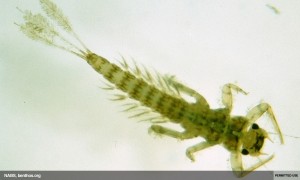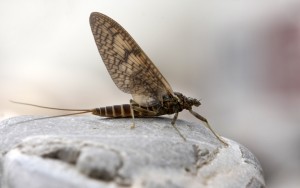The fifth graders are just finishing up a really great book called Night of the Spadefoot Toads by Bill Harley. Now there are a lot of great things to love about this book, but being the fifth grade science teacher, I love that it includes the fascinating topic of vernal ponds (also known as ephemeral ponds). Most of the students are aware that we have a pond in the woods behind our school that comes and goes, but they don’t know much about it.

Immediately I had students researching and finding out what they could about the words <vernal> and <ephemeral>. They found out that these two words do not share the same meaning, but are still appropriate names for the temporary pond we have in our own school woods! The narrative that follows here happened over a few days.
At Etymonline we found out that <vernal>means “pertaining to spring” and that it has been found in print as early as 1530. It is from Late Latin vernalis “of the spring”, from vernus “of spring”, from Latin ver, “the spring, springtime”.
After looking in several dictionaries, the sense of how to use the word broadened. We could speak of vernal sunshine, sweet vernal grasses, vernal ponds and the vernal equinox. Well, actually we couldn’t speak of a vernal equinox until we understood what it was!
I wrote the word <equinox> on the board and asked if anyone recognized any familiar morphemes. One person saw the word <ox>, and one boy saw his own name (Quin). I guess this is not surprising since so many scripted spelling programs use “finding unrelated words within a given word” as a strategy to help with remembering a spelling. That is another one of those misguided strategies that may help with remembering a spelling, but no doubt distracts the student who also needs to understand the word’s meaning. In my own opinion, it also reinforces the idea that spelling is about remembering letter order and not about understanding words so you can enjoy and use them.
So I explained that we were looking for morphemes (word parts with meaning), and that these would be prefixes, bases, or suffixes. Because morphemes carry meaning, as we put them together, they help us understand the whole meaning of the word. It was at that point that someone offered up “equal”. We looked in a dictionary to see what <equinox> meant. We found out that twice a year the length of our day and our night is nearly equal. The use of the word <equal> in the definition confirmed our idea that one of the morphemes in this word was <equ>. Since there is no <i> in the word <equal>, we thought that the <i> had to be either a connecting vowel (indicating Latin) or part of the other morpheme in the word. It was at this point that a boy in the back row raised his hand with great enthusiasm and wondered if the <nox> had something to do with night, seeing that the definition of an equinox mentioned equal length days and nights. Next stop – Etymonline!
We found out that the word may have come directly from medieval Latin equinoxium “equality of night (and day)! Smiles all around. The only question left to ask was, “So if an equinox happens twice a year, when is the vernal equinox? Confidently and with exuberance, the whole class answered, “In the spring!”
Next we were onto the word <ephemeral>. Since none of us recognized any morphemes in this word, we went right to a dictionary. The students found out that it meant “short lived, perhaps even as short as one day”. Then I remembered a word that I haven’t thought of since my husband was getting his Masters Degree in Aquatic Entomology and I was typing up his thesis. I thought of <ephemeroptera>. I knew it was an order of insects, but now I was ready to understand how or if it was related to the word <ephemeral>. I wrote <ephemeroptera> on the board and underlined the <pter>. Then I rewrote the <pter> to the side and asked if anyone knew a word that began with those four letters. I didn’t have to wait long. “Pterodactyl!”
I underlined the <pter> and shared that this morpheme was from the Greek pteron and meant “winged”. Then I wrote the word <helicopter> on the board. We looked together at the Etymonline entry for this word and found out that the first base is from Greek helix (genitive helikos) “spiral”. I reminded them that the <os> on <helikos> is a Greek suffix we have seen before (bios, lithos, cosmos, geos, tropos, thermos, hydros and mesos — when we were looking at word sums for biosphere, lithosphere, cosmosphere, geosphere, troposphere, etc.) I also shared with them the logical switch from a <k> in <helik> to a <c> in <helic>. I wrote the word sum next to it: <helic>+<o>+<pter>. Underneath the base <pter> I wrote “winged”. Underneath the base <helic> I wrote “spiral”. Then we imagined the movement of a helicopter.
I said to my students, “I don’t know about you, but recognizing the <pter> as a base in the word <helicopter> has been one of my favorite discoveries since I’ve started studying orthography!”
“Me too!” came a cry back from a couple of students with open-eye looks on their faces.
Side trip over, we got back on track with the word <ephemeroptera>. Somebody suggested that this was an insect with wings that lived only a short time. We looked online and found these: Mayflies.
The top picture is what they look like as nymphs when they live in water. The bottom picture is what they look like when they emerge as adults. They do indeed have brief lifespans as adults since they emerge without mouth parts and therefore do not eat! They try to mate within hours of becoming adults and die shortly afterwards. It certainly makes sense to call these insects ephemeroptera!
Another neat connection came two days later when I came across an article about a man who creates ephemeral art. His name is Andy Goldsworthy and he likes to use natural found materials to create his art. It is ephemeral because he creates it outdoors and leaves it there. Here is a lovely video of some of his work. His art may last longer than a mayfly, but the influence of the weather will certainly shorten the length of its existence. Some of it will definitely disappear once the vernal sunshine appears!
Next we went to Etymonline to see what else we could learn. The word has been in print since the late 14th century. It originally was a medical term and referred to a fever that lasted one day. It is from Greek ephemeros “daily, for the day”, also “lasting or living only one day, short lived”, from epi “on” + hemerai dative of hemera “day”. It wasn’t until the 17th century that it was used to refer to short lived insects and flowers, and it wasn’t until 1751 that it had the general sense of “a thing of transitory existence”. Fascinating!
Now that we had a deeper understanding of vernal and ephemeral, it was time to look closely at what goes on in a vernal or ephemeral pond.
This was an especially interesting film. After watching it we took a walk into our woods. Even though the recent rains meant there was water in our ephemeral pool, we now knew that it would not be there long enough for frogs to be laying eggs. That would happen in the spring when the water is there for a longer stretch of time. We imagined how the pool will be different in the spring and how much wider and deeper it will be. We decided that this pool can be called vernal because the spring is when it is full, and the life in it is active. We decided that this pool can be called ephemeral because it is not a pond like other ponds. It is only a pond for a short time.
Before we left the woods, we collected some thoughts on paper that we have since been crafting into poetry. Those will be ready to share soon! Stay tuned.


